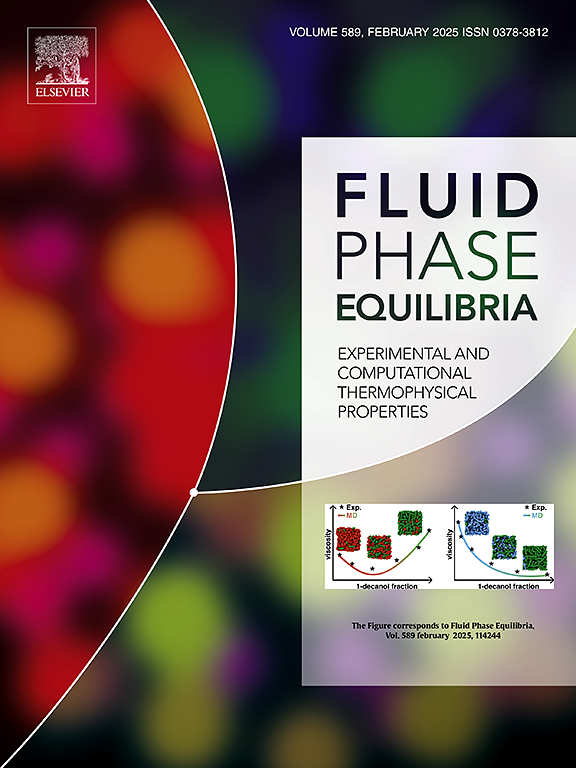On dispersion and polar interactions and solvation and cohesion energies. A first round
IF 2.7
3区 工程技术
Q3 CHEMISTRY, PHYSICAL
引用次数: 0
Abstract
Understanding the role of intermolecular interactions and their specific contributions to thermodynamic quantities remains one of the major goals of Molecular Thermodynamics. Numerous polarity scales and related divisions of intermolecular interactions have been proposed in the literature but the exchange of information between them is not always easy, causing often much confusion. The present work is part of a broader effort for the development of a solid thermodynamic framework for the reliable exchange of such information. The work is a continuation of our recent work on the prediction of the contribution of hydrogen-bonding interactions to solvation enthalpies and free-energies. It focuses on the rest of the contributions arising, primarily, from dispersion and polar interactions. The way these contributions are handled in the relevant literature are discussed. Emphasis is given on the QSPR (Quantitative Structure Property Relationships) - type approaches exemplified by the Linear Solvation Energy Relationship (LSER) approach. The results of two alternative LSER routes to the estimation of solvation enthalpies are critically evaluated and their limitations are discussed. Much emphasis is given on self-solvation, where the relations of solvation energies to cohesion energies, heats of vaporization and internal pressures are examined. Based on this evaluation, an effort is made to establish simple universal methods for the prediction of dispersion and polar contributions to solvation energies free, to a rather significant extent, from the above limitations. These new methods are using molecular descriptors based on quantum – chemical (QC) calculations and referred to as QC-LSER descriptors. The predictions are compared with experimental data and / or other predictive methods in literature. Extensive comparison with the original LSER calculations is made and reported in Supplementary Information file. The strengths, limitations and perspectives of the new approach are also discussed.
色散和极性相互作用,溶剂化和内聚能。第一轮
了解分子间相互作用的作用及其对热力学量的具体贡献仍然是分子热力学的主要目标之一。文献中提出了许多极性尺度和分子间相互作用的相关划分,但它们之间的信息交换并不总是容易的,经常造成很多混乱。目前的工作是为可靠地交换这类信息而发展一个固体热力学框架的更广泛努力的一部分。这项工作是我们最近关于氢键相互作用对溶剂化焓和自由能贡献的预测工作的延续。它着重于主要由色散和极性相互作用引起的其余贡献。讨论了在相关文献中处理这些贡献的方式。重点是QSPR(定量结构性质关系)型方法,以线性溶剂化能量关系(LSER)方法为例。两种替代的LSER路线的结果估计溶剂化焓是严格评估和他们的局限性进行了讨论。着重于自溶剂化,其中考察了溶剂化能与内聚能、汽化热和内压的关系。基于这一评价,我们努力建立简单的通用方法来预测色散和极性对溶剂化能的贡献,在很大程度上摆脱了上述限制。这些新方法使用基于量子化学(QC)计算的分子描述符,称为QC- lser描述符。将预测结果与实验数据和/或文献中的其他预测方法进行比较。与原始LSER计算进行了广泛的比较,并在补充信息文件中报告。讨论了新方法的优势、局限性和前景。
本文章由计算机程序翻译,如有差异,请以英文原文为准。
求助全文
约1分钟内获得全文
求助全文
来源期刊

Fluid Phase Equilibria
工程技术-工程:化工
CiteScore
5.30
自引率
15.40%
发文量
223
审稿时长
53 days
期刊介绍:
Fluid Phase Equilibria publishes high-quality papers dealing with experimental, theoretical, and applied research related to equilibrium and transport properties of fluids, solids, and interfaces. Subjects of interest include physical/phase and chemical equilibria; equilibrium and nonequilibrium thermophysical properties; fundamental thermodynamic relations; and stability. The systems central to the journal include pure substances and mixtures of organic and inorganic materials, including polymers, biochemicals, and surfactants with sufficient characterization of composition and purity for the results to be reproduced. Alloys are of interest only when thermodynamic studies are included, purely material studies will not be considered. In all cases, authors are expected to provide physical or chemical interpretations of the results.
Experimental research can include measurements under all conditions of temperature, pressure, and composition, including critical and supercritical. Measurements are to be associated with systems and conditions of fundamental or applied interest, and may not be only a collection of routine data, such as physical property or solubility measurements at limited pressures and temperatures close to ambient, or surfactant studies focussed strictly on micellisation or micelle structure. Papers reporting common data must be accompanied by new physical insights and/or contemporary or new theory or techniques.
 求助内容:
求助内容: 应助结果提醒方式:
应助结果提醒方式:


